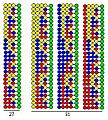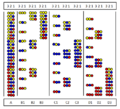Combinatorial chemistry facts for kids
Combinatorial chemistry is a special part of chemistry where scientists make a huge number of different chemical compounds at the same time. They use special methods and often robots to create these new substances. After making them, they test these compounds to find ones with useful properties, like new medicines. This method is mostly used in medicinal chemistry and pharmacology to discover new drugs.
Contents
What is Combinatorial Chemistry?
Combinatorial chemistry is like having a super-fast factory for molecules! Instead of making one chemical compound at a time, this method lets chemists create thousands, or even millions, of different compounds all at once. Imagine you have a set of building blocks, and you want to see all the different towers you can build. Combinatorial chemistry does something similar with chemical "building blocks" to make many new molecules.
Why Do Scientists Use It?
Scientists use combinatorial chemistry mainly to find new medicines. When they are looking for a new drug, they need to test many different chemicals to see which one works best against a disease. Making each chemical one by one would take a very long time. Combinatorial chemistry speeds up this process a lot, helping them find useful compounds much faster. It's also used to find new materials for other purposes, like better plastics or stronger glues.
How Does It Work?
The main idea behind combinatorial chemistry is to mix and match different chemical parts. Think of it like making different sandwiches. You have different types of bread, fillings, and toppings. By combining them in different ways, you can make many unique sandwiches.
Chemists use a similar idea:
- They start with a basic chemical structure.
- Then, they add different "building blocks" to different parts of that structure.
- They do this in a very organized way, often using small beads or supports, and robots help with the mixing and reactions.
This process creates a "library" of many different compounds. Each compound in the library is slightly different from the others.
Making Many Compounds at Once
One common way to do this is called "split-mix synthesis." Imagine you have a large group of tiny beads.
- First, you divide the beads into several smaller groups.
- You add a different chemical building block to each group.
- Then, you mix all the beads back together.
- You split them again into new groups and add another different building block to each.
By repeating these steps, each bead ends up with a unique combination of building blocks, meaning each bead holds a different chemical compound.
Finding the Best Compound
Once the library of compounds is made, the next step is to test them. Scientists have special tests that can quickly check thousands of compounds to see if they have the desired effect. For example, they might test which compound can stop a certain type of bacteria from growing, or which one can block a specific protein in the body.
When a compound shows a promising result, scientists can then figure out its exact structure. They can then make more of that specific compound and study it in more detail to see if it can become a new medicine.
Images for kids
See also
 In Spanish: Química combinacional para niños
In Spanish: Química combinacional para niños






